Lebanon
 From Rationalwiki
From Rationalwiki _-_LBN_-_UNOCHA.svg.png)
“”The Soviet occupation of Afghanistan gave us the Taliban. The American occupation of Saudi Arabia gave us bin Laden and Al Qaeda. The Israeli occupation of Lebanon gave us Hezbollah.
|
| —As'ad AbuKhalil, Lebanese-American professor of political science at California State University.[1] |
The Republic of Lebanon is a small country on the eastern Mediterranean coastline wedged between Israel to the south and Syria to the north and east. Its capital and largest city is Beirut. Lebanon is notable for having an extremely diverse population, and religiously, the Lebanese people are roughly evenly divided between Islam and Christianity, with a significant Druze minority for added flavor. Sadly, though, Lebanon is at the peak of a political and economic crisis that has been brewing for decades. The terrorist group Hezbollah occupies much of its territory and strongarms its government,[2] and the country's economy has collapsed due to some awe-inspiringly bad decisions by its central bank.[3]
In ancient times, though, Lebanon was a great center for civilization and trade. A great maritime and trading culture, the Phoenicians flourished here for about three thousand years. In 64 BCE, the region came under the rule of the Roman Empire and eventually became one of its leading centers of early Christianity. The Christian religion was so entrenched here that it remained a powerful force in Lebanon even after the region's conquest by the followers of Muhammad. During the Crusades, Lebanon fell under temporary Crusader rule. The Ottoman Empire's conquest of the area was more successful, and Lebanon remained under Turkish rule until World War I. After that, some shady backroom fuckery saw Lebanon get handed off to France as an effective colonial possession. The French would define Lebanon's modern borders, incorporating a bunch of Muslims. Having successfully turned Lebanon into a potential powder keg, the French released Lebanon to independence in 1943.
By carefully establishing a power-sharing arrangement among the different religious groups, Lebanon actually kept itself a stable and prosperous state during the first decades of its independence. The good times went up in flames in 1975 when Cold War tensions and Israel-Palestine trouble caused Lebanon to erupt in a bloody civil war. The conflict lasted decades, featured war crimes and ethnic cleansing, and resulted in military occupations and invasions by Israel and Syria. Israel's occupations infuriated much of Lebanon's Muslim population, leading to the rise of Hezbollah.
Lebanon had previously been sucked into another conflict with the Syrian Civil War raging next door. Fortunately, on 28 August 2017, the spillover from the Syrian Civil War left Lebanon after the so-called "Syrian rebels", "Islamic State", and various al-Qaeda affiliates were outgunned by the Lebanese military and Hezbollah. This is a rare example of Hezbollah doing the right thing for a change. Nevertheless, Lebanon remains in a precarious situation. With Iran and Israel grappling for influence over their neighbors, Lebanon still has its work cut out to avoid being sucked into yet another devastating conflict.
Historical overview[edit]

Phoenicians[edit]

Lebanon has been inhabited for a long time, but it first appeared in recorded history around 3000 BCE. It was described by the Ancient Greeks as a group of coastal cities that became enormously wealthy by selling a highly fashionable purple dye.[4] The Greeks called these people the "Phoenicians" after the Greek name for this purple dye, but the people themselves actually called their land Lebanon.
First produced in the Phoenician city of Tyre, Imperial Purple was a dye extracted from shellfish that proved to be highly resistant to fading.[5] The difficulty in processing it and its unique color made the dye enormously expensive. As a result, Imperial Purple became a symbol of wealth and prestige in places like the Roman Empire and Carthage.[5]
The Phoenicians lived throughout many independent city-states, each of which served as an essential hub for maritime trade. Cities like Tyre and Sidon were hugely influential in the ancient world and still exist today, while Phoenician colonies like the city of Carthage built their own trade empires. The Lebanese Phoenicians also invented the world's first phonetic alphabet (from which we get the word), which revolutionized communication around the ancient world.[4] Being a phonetic alphabet of 22 simple letters, the Phoenician writing system was easy to learn and adapt. From the Phoenician alphabet evolved the Aramaic alphabet, which evolved into modern Arabic.[6] The Greeks also adopted the Phoenician alphabet, and from them, we get the Latin alphabet utilized in many European languages, including the one this article is written in.[6] That's all pretty cool, and it came from the Middle East.
Ancient conquests of Lebanon[edit]
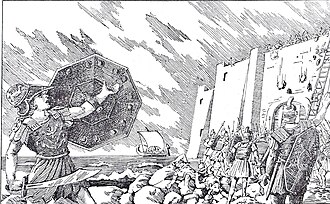
By being wealthy but not super powerful, the Phoenician city-states were obvious targets for anyone who wanted to do some empire-building. The Assyrians rolled in first from Mesopotamia and treated the Phoenician cities with their characteristic brutality, massacring anyone who tried to resist.[7] Later came the similarly cruel Neo-Babylonian Empire, followed by Persia's much more benevolent Achaemenid Empire. Happy with this change in pace, the Phoenicians became quite loyal to Persia during the wars with Greece.[8] These wars, as wars do, bankrupted the Persian Empire. To make it up, the Persians burdened the Phoenicians with heavy taxation, and the Phoenicians became restive again.
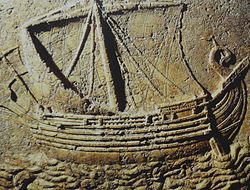
The Persian Empire was cut short when Alexander the Great rolled in seeking to build his own empire. At first, the Phoenicians were indifferent, but they decided to resist this new invader when Alexander accidentally insulted their pagan religion. In retaliation, Alexander besieged Tyre, the largest and most important Phoenician city. Tyre held out for seven months until Alexander had his army painstakingly build a causeway to reach the island city. So enraged was Alexander at this setback that he ordered much of Tyre razed and around 8,000 of its citizens put to death, and 30,000 more sold into slavery.[9]
After Alexander's untimely death and the partitioning of his empire, Lebanon once again came under Persian rule. However, the Persian Empire was led by Seleucus, a Greek general who had served under Alexander. The Seleucid's time was unhappy due to its constant warring against the other post-Alexander states like Ptolemaic Egypt and Macedonia proper under Antigonus. Critical in these conflicts was Lebanon, which was still rich and which Persia and Egypt battled over repeatedly for more than four decades.[10]
In 64 BCE, though, the Roman Empire arrived to conquer Lebanon. The era of "Pax Romana" saw the Phoenician cities become especially prosperous due to being connected to the Roman trade network.
Romans and Christianity[edit]
.jpg)
During Roman rule over Lebanon, Christian scriptures claim that Jesus himself visited Tyre to heal a demon-possessed child.[11] It's also claimed that Saint Peter himself converted much of the Lebanese population to Christianity through evangelization.[12] While these tales are disputable at best, it is clear that Lebanon began the process of Christian conversion very early on in that religion's history, placing it next to Armenia as an early bastion of the Christian faith. While Christianity spread very quickly in Lebanon's coastal trading cities, it was much slower in Lebanon's harsh mountainous hinterlands.[13]
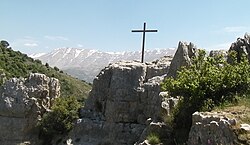
Christianity in Lebanon became heavily influenced by Saint Maron, who founded a community of monks near Aleppo around 400 CE and focused on spiritualism and asceticism.[14] This community evolved into the Maronite Church, which became the most influential religious community in Lebanon and still remains powerful there to this day.[15] An interesting crossroads between Eastern and Catholic Christianity, the Maronite Church remains on good terms with both.
Mount Lebanon, which, as you can guess, is in Lebanon, became a significant site for the Roman Empire's adoption of Christianity. Emperor Constantine demolished a Temple to the Roman goddess Venus here, and the mountain subsequently became a center of operations for the Maronite Church.[16]
After the partitioning of the Roman Empire and amid the rising power of the Arabs, the Byzantines introduced a group of newly-converted Middle Easterners called the Mardaites. The latter became an essential part of the Byzantine military and helped fortify and defend the Maronites in Lebanon.[17] The Mardaites are a big part of why Maronite Christianity survived the oncoming invasion of Islam.
Islamic rule and the Crusades[edit]
_-_panoramio.jpg)
Under the leadership of Muhammad, the disunited tribes of Arabia united around the brand-new religion of Islam and began seeking to expand their faith. They immediately came into conflict with the Byzantine Roman Empire, even before Muhammad's death, starting with the 629 CE Battle of Mu'tah.[18] The Byzantines won that first encounter, but after Muhammad's death in 632, his successors were determined to carry on spreading the new religion. The Battle of Yarmouk in 636 was a decisive victory for the Muslim caliphate due to their superior tactical prowess, and it cleared the way for the Muslims to quickly claim most of the Levant.[19]
Despite large amounts of Arab immigration into the region, the conversion of Lebanon's population to Islam was very slow and remains incomplete to this day. Arab rule did, though, have a profound impact on Lebanon and the wider East Mediterranean world. The immigration of Arabs and other groups into Lebanon helped turn it into today's culturally diverse place. Other Christian sects fleeing from the Arabs joined the Maronites in the mountains, growing the number of Christians who could shelter there and avoid conversion to Islam.
.jpg)
Around 1021, another religious minority joined them. Al-Hakim, the Fatimid caliph of Egypt, proclaimed himself an incarnation of God. Two of his followers, Hamza and Darazi, formulated the dogmas for his cult.[20] This movement grew into a new religion: the Druze. The Druze faced hideous persecution across the Arab world, so they (say with us now) fled into the Lebanese mountains for protection.[21] Although reasonably friendly to other religions, even the Jews, the Druze largely kept to themselves. They also did an admirable job of defending their communities in the mountains.
In general, though, the Arab rulers were remarkably tolerant toward the vast community of Lebanese Christians and Jews. In exchange for significantly higher taxation, they got to manage their own affairs and were even exempt from military service.[20]
Lebanon became one of the most impacted regions by the Crusades. The Catholic forces turned their attention to Lebanon during the First Crusade after capturing Jerusalem in 1099. Tripoli capitulated in 1109; Beirut and Sidon in 1110. Tyre stubbornly resisted but finally capitulated in 1124 after a long siege. All of these cities together became the new Crusader state, the County of Tripoli, which served as a vassal to the Kingdom of Jerusalem.[22] As one of the frontiers of Crusader Christianity against the Muslim world, Lebanon saw a huge building spree of castles and forts around its territory meant to defend it from reconquest. Sure enough, the County of Tripoli was one of the longest-lived Crusader outposts in the region, lasting until its capture by the Egyptians in 1289.[23] Among the longest-lasting legacies of the Crusades in Lebanon were the ties established between the Catholic Church and the Maronite Church. The two communities are still in communion.[24] Heavy French involvement in the Crusades meant that France also took an abiding interest in Maronite affairs which would intensify over time.
Ottoman rule[edit]
-2.png)
After a long struggle between Egyptians, Mongols, and Arabs for power in Lebanon, the Turkish-ruled Ottoman Empire won supreme in the early 1500s. Meeting personally with Lebanese ruler Emir Fakhr al-Din I, the Ottoman sultan at the time, Salim I, granted autonomous status to Lebanon's Druze and Christian communities.[25]
Under the Druze-following Maan family, Lebanon's people strove for independence. Fakhr al-Din II built up Lebanon's military and economic capacity and made great steps toward uniting Lebanon's religious groups under a single Lebanese identity.[26] He fucked up, though, by striking a defensive pact with Ferdinand I of Tuscany against the Ottomans, resulting in a retaliatory series of wars that concluded in 1635 with his execution.[26]

The Ottomans replaced the Maan family with the Shihab family, who eventually proved similarly disloyal. Under Bashir II, Lebanon refused to aid the Ottoman war effort against Napoleon Bonaparte during his invasion of the Levant. Then Lebanon joined Muhammad Pasha in Egypt's war for independence against the Ottoman Empire.[27] So hard to find loyal puppet rulers, isn't it?
The scheming Shihabs then caused Lebanon to blow up into its first great internal conflict through their misrule. In 1860, the Maronites of Lebanon rose up against the Shihabs' high taxes and strict religious laws. Christians, Druze, and Muslims turned against each other in a horrible storm of violence. The civil war resulted in about 20,000 deaths across all sides. The violence was so bad that France threatened the Ottomans into allowing a small French military expedition into the region to protect the Maronites.[28] French troops remained in Lebanon until mid-1861.
France and other European great powers would remain influential in Lebanon, as they cowed the Ottomans with gunboat diplomacy, allowing them to oversee their relations with the Maronite Christians.
World War I[edit]

“”They lost so many loved ones during that time. My father once said that the rich families survived as they were able to bribe and get supplies on the black market. It was the unemployed, the middle class and the poor that were dying in the streets.
|
| —Teresa Michel, son of famine survivors.[29] |
Lebanon also suffered horribly during World War I. The Ottoman government abolished Lebanon's autonomous status and placed it under harsh military occupation.[30]
Jamal Pasha, then minister of the navy, became the leader of the Ottoman occupation force in Lebanon. He was known for giving no shits about how his military policies impacted the Lebanese population. This was illustrated most clearly when Jamal decided to place a blockade over the entire eastern Mediterranean to starve the British troops in Egypt.[30] Instead, this stupidly broad and short-sighted policy caused misery in Lebanon, where crop failures had forced people to rely on shipments that now weren't coming. The resulting famine killed about half of Lebanon's population, with corpses piling in the streets and some people resorting to cannibalism for survival.[31]
Turkish forces also cut down Lebanese forests for wood and executed suspected dissenters without trial. The horror didn't end until British and Arab troops arrived to force the Turkish occupiers out of Lebanon. Even then, though, Lebanon's exploitation would not end, for it was then passed off to French rule by the League of Nations per the backroom Sykes-Picot deal.[30] What a pisser.
French mandate[edit]
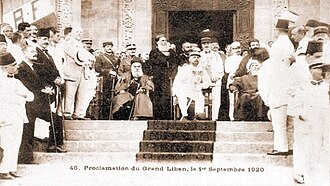
Having been given a blank check by the League of Nations to force Lebanon under French rule, France went about remodeling Lebanon to suit their needs. The Maronites, who had long been friends with the French, welcomed this. As a result, the French generally favored the Maronites over the other Lebanese.[32] In 1920, though, the French expanded the borders of Lebanon to where they are in the modern day. This included large numbers of Muslims in the new state, which turned the Maronites into a threatened minority.[32] Many Arab Muslims were also still a bit sore that the Entente powers had promised to create a unified Arab state but had instead carved up the Middle East in the name of colonialism.
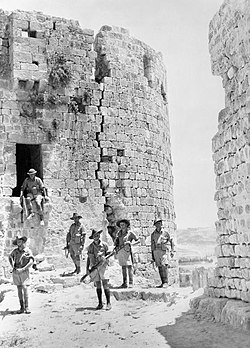
Realizing that they might have miscalculated a bit, the French decided to ease tensions between the Lebanese by promulgating a new constitution to ensure equal say in government for all religious groups. Modeled after the French Third Republic, the constitution allowed seats to be filled based on religious identity. Thus, the president would be a Maronite Christian, the prime minister a Sunni Muslim, and the Speaker of the Chamber of Deputies a Shia Muslim.[33] If that sounds like an awfully inefficient form of government, don't worry. The French never actually intended for the Lebanese government to do anything. Instead, the French colonial high commissioner held all of the real power and could override any parts of the Lebanese government.[33] Colonialism!
During World War II, Lebanon was contested between Free France and Vichy France. With aid from the Allies, Free France was able to reoccupy Lebanon in 1941. But first, however, they had to deal with the Lebanese. In exchange for supporting the Allies, the Lebanese leaders asked General Charles de Gaulle to end the French mandate and let Lebanon be free.[34] De Gaulle was reluctant, but the need to use Lebanon as a base for war against the Axis outweighed France's imperial pride. Despite that agreement, though, de Gaulle was determined to keep French control over Lebanon for at least the duration of the war. When Lebanon had the gall to hold elections in 1943 and declare its independence, de Gaulle had the entire Lebanese government thrown in the clink, including the president and prime minister.[34][35] This action backfired beautifully, as the Christians and Muslims lovingly united under the "fuck France" sentiment. With Lebanese unrest threatening to become a real problem and France's allies being very annoyed at this unnecessary drama, de Gaulle finally caved and released the political prisoners. Lebanon thus gained its independence shortly after that.
France left Lebanon both better and worse than they found it. France had rebuilt Lebanon's economy and infrastructure from the devastation of World War I, but France's habit of favoring Christians over Muslims had pushed the two groups apart and made mutual understanding more difficult. Lebanon's next steps would have to be taken carefully.
The good years[edit]

Lebanon's post-independence government had to be cobbled together to maintain national unity. In an arrangement between the most prominent Christian and Muslim leaders, Lebanon was to be built on the following principles:[34]
- Both Christians and Muslims had to swear off any foreign ties. That meant no loyalties to France and no aspirations of joining an Arab state.
- Lebanon would be an Arab state, but it would not abandon Western cultural influences.
- Public offices would be distributed proportionally among religious groups.
- The three top government positions should be distributed as follows: the republic's president should be a Maronite; the prime minister, a Sunni Muslim; and the Speaker of the Chamber of Deputies, a Shia Muslim.
This was, as you can see, an extraordinarily fragile agreement. As 1975 would prove, this arrangement could only function if the Lebanese people wanted it, and it could easily fall apart amid internal pressures.
However, Lebanon's early years proved quite peaceful and prosperous. The Lebanese people held a corrupt leader accountable in the nonviolent "Rosewater Revolution", giving way to a new regime committed to ending sectarianism and increasing social equality.[36] Additionally, Lebanon became a tourist hotspot and a center for finance. Undergoing a spree of development and cultural progress, Beirut became known as the "Paris of the Middle East."[37]
Rising tensions[edit]

Unfortunately, religious discontent soon started simmering again. Muslims and Christians in Lebanon's government had an angry dispute over whether to hold a national census, which Muslims were convinced (rightly) would prove their numerical superiority.[38] The Christians realized this too and did their best to block any attempts at counting the populace. This numerical imbalance became extreme when tens of thousands of Palestinians fled Israel into Lebanon after the 1948 Zionist victory in the civil war.

Tensions briefly exploded during the Suez Crisis, when France, Israel, and the United Kingdom teamed up to unjustly attack Egypt to retake the Suez Canal. When Lebanon's Christian president refused to condemn the attack in 1958, Muslims rose up across the country in a violent insurrection.[39] Lebanon's president called on the United States for help, and US Marines landed there for a three-month intervention.
After that, Lebanon returned to a peaceful existence, but things went sour again when Israel went to war in 1967. Israel's victory and Jordan's subsequent falling-out with the Palestinian Liberation Organization (PLO) saw the PLO pack their bags and move into Lebanon instead. This threw Lebanon into chaos, as Muslims supported the PLO, and Christians saw the PLO as a threat to Lebanese integrity and independence.[40]
Opponents to the PLO's presence in Lebanon (rightly) feared that Israel would launch aggressive reprisals against Lebanon for hosting them. This fear came true in 1968 when Israeli commandos attacked Beirut International Airport to blow up 14 airplanes.[41] This raid earned a rare rebuke from the US, who couldn't ignore that there was zero evidence that Lebanon or its airport had anything to do with the PLO.[42]
Despite Lebanon's refusal to cooperate with the PLO, the PLO built a substantial military force within southern Lebanon by recruiting displaced Palestinians from refugee camps. By the early 1970s, the PLO was operating a "state within a state" where it could act with impunity.[43]
Civil war[edit]

With the Christians and Muslims at each other's throats over power and the PLO, and the PLO operating as an effectively independent entity in southern Lebanon, there was only one more item needed to complete the recipe for civil war. This was the Phalange Party. This was a Christian, pro-Western, and fascist organization that wanted to excise Arab and Muslim people from Lebanon and return the country to a "Phoenician" identity.[44] They gained power steadily by building murderous militias and even being called upon by Lebanese presidents for support.

Naturally, the Phalange came into conflict with Muslims and Palestinians. In 1975, the spark that lit the Lebanese fuse came when Phalangists and Muslims had a gunfight that killed four.[45] The Phalangists then blew up a bus full of Palestinian civilians. Fighting began in earnest throughout the streets of Beirut, and Lebanon's fragile government completely shut down over the issue of whether to send troops to stop the fighting. As other groups joined in, warfare soon spread across Lebanon. The war wasn't cleanly Christian vs. Muslim. The Christians split between those who wanted to maintain the status quo and those who supported the Phalangists' plan of ethnic cleansing.[45]
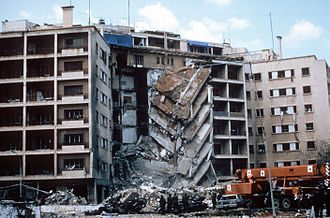
By 1976, other nearby powers were getting involved. Syria sent in troops ostensibly to keep the peace but actually in an attempt to pave the way for annexation.[46] In 1978, Israel hopped in on the fun by invading southern Lebanon to flush out the PLO. The operation failed. Israel withdrew later that year, instead preferring to hand off operations to a breakaway army force led by Major Saad Haddad, which served as Israel's main proxy on the ground.[46]
In 1982, amid more attacks by the PLO, Israel decided to invade Lebanon again. This turned the tide of the war in favor of the Phalangists, who took the opportunity to start massacring Muslim civilians with impunity. Meanwhile, Israeli forces looked on and did nothing.[47] The Sabra and Shatila massacre was most infamous, where Phalangist militias killed some 3,500 people in Palestinian refugee camps.[48] They did it in plain view of Israeli forces.

Infuriated at the Israeli occupation of southern Lebanon, many Shia Muslims put an army together. They started receiving cash and guns from Iran to force Israel out.[49] They called themselves Hezbollah or the "Party of God". In its struggle against Israel, Hezbollah became enormously popular due to its (basically truthful) claim of fighting for Lebanese independence against Israeli aggression.[49] Hezbollah would leverage this popularity into genuine political power within Lebanon.
Hoping to calm things down, the US, France, and Italy teamed up to send troops into Lebanon in 1982. They instead escalated things, as nobody in Lebanon really wanted any more European occupations, and the multinational force became seen as just another power-hungry belligerent faction.[50] Hooray for saving the day! Iranian-backed militias in Lebanon struck back. First, in April 1983, they sent a suicide bomber to destroy the US embassy in Beirut, killing 63 people.[51] In October of the same year, they sent suicide truck bombers to hit the barracks of the US and French troops, killing 241 US soldiers and 58 French soldiers.[52] Amid the collapse of the Lebanese army and the horrific and unexpected death toll, the multinational force withdrew in 1984.[53]
Amid a spree of vicious warfare and political assassinations, Lebanon became split between a rogue military government and a civil government headed by a Sunni Muslim. Peace talks came at last in 1989 after the Christian factions exhausted each other by warring against each other and Syria. A final agreement reshuffled the religious power balance in Lebanon.[46] Despite attempts to scuttle the peace, the war officially ended in 1990. Once a jewel of the Middle East, Lebanon was left in rubble.
All in all, at least 150,000 people died in the war.[54]
Reconstruction[edit]
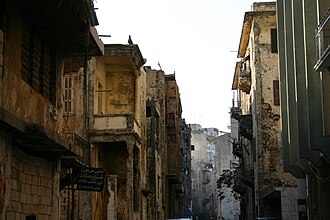
Lebanon's immediate postwar challenge was to rebuild its economy and infrastructure. The war had left many of its cities reduced to rubble and most of its people homeless and jobless. Syria also still occupied significant portions of Lebanon even in peacetime, ostensibly to ensure the country's "protection".[55]
Apparently exhausted by war, Lebanon's government managed peaceful transitions of power throughout the 1990s while elected leaders tried to reestablish Lebanon as an economic power.[56] Unfortunately, while the peace accords called for an end to sectarianism and religiously-split government, religious factions were only entrenched further in their "us vs. them" mindset. Even worse, the Iranian-backed militia Hezbollah started to entrench itself in significant portions of Lebanon.
Hezbollah assassinated Lebanese prime minister Rafic Hariri in 2005 via truck bomb, sparking significant political change.[57] Many Lebanese suspected that the Syrian occupiers had arranged Hariri's assassination, and they poured into the streets in furious protest. The nonviolent Cedar Revolution successfully forced the withdrawal of Syrian forces and a reshuffling of the government.[58]
More war[edit]
.jpg)
So, it looked like Lebanon would struggle back to its feet for a while. Tragically, Hezbollah and Israel had other ideas. After being the face of anti-Israel resistance during the civil war, Hezbollah had become a mighty political force within Lebanon. It occupied multiple seats in Lebanon's legislature and wielded disproportionate influence due to its ability to veto legislative actions and boycott votes.[49] Even after the civil war, Hezbollah's main focus was hostility to Israel.
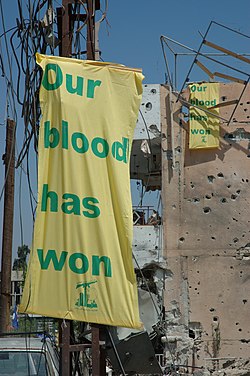
Hezbollah escalated its war against Israel throughout the early 2000s by shooting rockets into Israeli territory. In 2006, the final straw came when Hezbollah militants crossed into Israel and killed 10 IDF soldiers.[59] Enraged, Israel declared war on Hezbollah and launched a full invasion of Lebanon.
Unlike Israel's previous enemies, Hezbollah wasn't under any delusions that it could stand up against Israel's military might. Instead, Hezbollah fighters avoided direct conflicts and shot rocket after rocket into Israeli cities.[60] Israel retaliated by indiscriminately bombing any piece of Lebanon where rockets came from, leveling Lebanese cities and villages, and infrastructure.[61] The ground war, however, was a complete failure. After 34 days of brutal fighting, Israel withdrew, leaving Lebanon in ruins but Hezbollah intact.
Instead, the war backfired on Israel tremendously. Hezbollah gained even more support than ever (people didn't like Israel bombing their homes), and the Lebanese government's ability to reign in Hezbollah had been wholly destroyed.[62] As a result of Israel's first genuine military defeat, Hezbollah transformed into a group that is now more powerful than the Lebanese government and can do whatever it wants. Good job, Israel!
It gets worse before it gets better (and it hasn't gotten better)[edit]
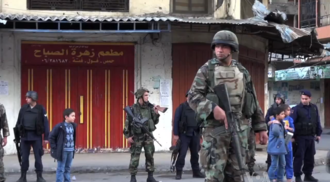
The aftermath of the Israeli war plunged Lebanon back into instability. In 2007, an opportunistic Sunni terrorist group called Fatah al-Islam tried to launch an uprising against Lebanon's government in Tripoli, leading to the worst internal fighting since the civil war.[63] In 2008, the pro-Western Lebanese government tried unwisely to rein in Hezbollah, leading to more violent clashes and an intervention from the Arab League to prevent a new civil war.[64] Basically, the impression you should be left with is that Lebanon was an absolute clusterfuck during this time.
So, this is the part where Lebanon's plucky people put aside their differences and work together for a shared better future, right? Ha! No.
In 2012, Lebanon's other neighbor Syria collapsed into the Syrian Civil War. Lebanon's border with Syria is quite large, and Syrian affairs have long been a concern in Lebanon. With the Syrian Civil War pitting religious enemies against each other, it's no surprise that it reignited sectarian conflicts in Lebanon. Sunni and Shia Muslims split, and Hezbollah and other Sunni groups sent fighters into Syria.[65] It didn't sit well with any faction that their enemies were aiding the wrong side in the Syrian war, so cue a bunch of car bombings across Lebanon as Sunni groups and Hezbollah used terrorist tactics against each other.[66] As you can imagine, the poor fucking Lebanese people got caught in the middle.
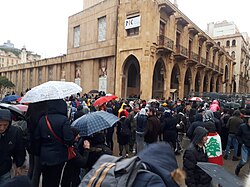
The war also spilled into Lebanon, most notably in 2014 when DAESH and the Al-Nusra Front teamed up to attack a Hezbollah town near the Syrian border.[67] The resulting Battle of Arsal lasted five days and killed dozens on both sides.[68]
If that wasn't enough, Lebanon's government has made some truly baffling financial choices that culminated in a crushing financial crisis. Lebanon spent itself into huge debt, then tried to attract foreign investors by hiking interest rates and pegging its currency to the US dollar.[69] The central bank continued to pay higher and higher rates to attract funds into the country, despite those dollars being insufficient to cover interest and capital payments. Meanwhile, the Central Bank ran a Ponzi scheme by encouraging smaller banks to lend to it and then be paid with Lebanese government debt.[69] Thus, when Lebanese debt exploded, it took down most of the banks in Lebanon and caused their own little Great Depression. Why did they do this? Good old-fashioned corruption. The banks paid dividends to politicians, who were thus encouraged to look the other way. Lebanese leaders may be divided by religion, but they are united by greed.
Civil disobedience and anti-government protests in Lebanon began in 2019 and are still ongoing.[70] They forced the resignation of the old government, but the new government is almost entirely composed of and supported by Hezbollah.[71] This places an Iranian within dangerous proximity of full power in Lebanon.
Government and politics[edit]
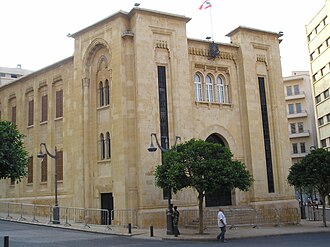
Confessionalism[edit]
Lebanon is an interesting example of parliamentary democracy. Lebanon places a unique spin on the parliamentary model by throwing a system called "confessionalism" into the mix. All of Lebanon's Parliament seats are apportioned according to religion to ensure that each religious group has a say in government. For example, Maronites are guaranteed 34 seats, Sunnis get 27 seats, Shias also get 27 seats, and Druze get 8 seats.[72] Despite the mandatory stipulation that each seat is filled by a member of that religion, who specifically gets the seat is up to voters belonging to that religious group.[73] Lebanon has universal suffrage.
High-ranking government posts in Lebanon also come with religious requirements. The President, for example, has to be a Maronite Christian, the Prime Minister a Sunni Muslim, and the Speaker of the Parliament a Shia Muslim. Meanwhile, the Deputy Prime Minister and the Deputy Speaker of Parliament must be Eastern Orthodox.
Confessionalism historically maintained peace in Lebanon by ensuring that everyone felt represented. However, it also sowed the seeds for future conflict by pitting religions and regions against each other as political opponents.[74]
Lebanon's recent political troubles arising from its financial crisis and the Syrian war have caused many leaders to rethink the politico-religious system. Current Lebanese President Michel Aoun has stated that he hopes to end the confessionalist system, but Hezbollah has announced its firm opposition to this idea.[75]
Hezbollah[edit]
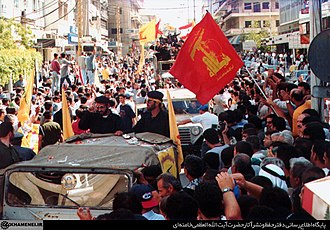
Founded in the chaos of the Lebanese Civil War and the occupation of southern Lebanon by Israel, Hezbollah has been a powerful force in Lebanese politics ever since. Hezbollah was and is heavily influenced by Iran, effectively functioning as its proxy. Iran and its Islamic Revolutionary Guard Corps (IRGC) provided the original funds and training that got Hezbollah off the ground. Hezbollah has carried out attacks on Iran's behalf against Israel and other targets.[76] They currently occupy big chunks of southern Lebanon. It's the most powerful non-state actor globally, and its military force is significantly greater than that of Lebanon itself.[77]
Although Hezbollah initially hoped to transform Lebanon's multi-religious democracy into an Iranian-style Shia theocracy, they later abandoned that idea after it proved rather unpopular.[49] They've since adopted a more "inclusive" message focusing on the idea that Israel is an illegitimate state and must be destroyed.
Despite getting Lebanon involved in multiple devastating wars, Hezbollah remains popular due to its strategy of providing charity, education, and social functions.[78] Hezbollah spends hundreds of millions of dollars yearly operating hospitals, schools, and agricultural aid services.[79] As a result, healthcare is much easier and cheaper to access in Hezbollah-controlled areas. That buys a lot of goodwill.
After the protests in 2019 forced the resignation of much of Lebanon's government, Hezbollah gained a vast amount of influence. The government of incoming Prime Minister Hassan Diab is supported almost exclusively by Hezbollah members in the Lebanese Parliament.[80][71]
Palestinian and Syrian refugees[edit]
.jpg)
Lebanon is host to over 470,000 Palestinian refugees, many of whom are concentrated in Lebanon's twelve huge refugee camps.[81] Conditions in the camps are awful, characterized by overcrowding, poor housing conditions, unemployment, poverty, and lack of access to justice. Palestinians are denied many civil rights in Lebanon, including the right to work and own property.[81] One of the most famous of these camps is Shatila, near Beirut. Shatila was the site of a hideous massacre by Phalangist forces, but it's grown significantly since then to the point where shelters are dangerously stacked.[82]
Palestinians, for their part, are furious with the situation and believe probably correctly that they're the victims of systemic racism. They have to get documented to work, but Lebanon doesn't like to give this documentation and routinely shuts down any Palestinian attempts to make a living there.[83] Palestinians are also denied citizenship and are classified as foreigners, although most of them, by this point, were actually born in Lebanon.[84] Because they are not formally citizens of another state, Palestinian refugees cannot claim the same rights as other foreigners living and working in Lebanon.
Lebanon has recently received a vast influx of Syrian refugees, and they treat these newcomers in a similarly shitty manner. Lebanon hosts more than 1 million Syrian refugees and only allows them to build shelters made of canvas and wood while banning them from establishing any official refugee camps.[85] Lebanese authorities order Syrian refugees to knock down their own homes if those homes are built without authorization. Syrian refugee "camps" charge high rent, provide salty drinking water, and are often infested with rats.[86] Conditions have gotten so bad for Syrians that many regret entering Lebanon and wish they had the money to return.
Gallery[edit]

Beirut skyline.
Platter of mixed Lebanese foods.
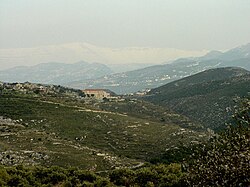
Lebanon's rugged landscape.
.jpg)
Lebanese women making fishing nets.

Maronite cathedral next to a mosque in Beirut.
See also[edit]
- Iraq
- Syrian Civil War
- Yemen
References[edit]
- ↑ As'ad AbuKhalil. Wikiquote.
- ↑ Profile: Lebanon's Hezbollah movement. BBC News.
- ↑ Lebanon: Why the country is in crisis. BBC News.
- ↑ 4.0 4.1 Lebanon: The Phoenicians. Country Studies.
- ↑ 5.0 5.1 Tyrian Purple. Ancient History Encyclopedia.
- ↑ 6.0 6.1 The Phoenician Alphabet & Language. Ancient History Encyclopedia.
- ↑ Lebanon: Assyrian Rule. Country Studies.
- ↑ Lebanon: Babylonian Rule and the Persian Empire. Country Studies.
- ↑ See the Wikipedia article on Siege of Tyre (332 BC).
- ↑ The Seleucid Dynasty. Country Studies.
- ↑ Matera, Frank J. (2001). Strategies for Preaching Paul. Liturgical Press. p. 186. ISBN 978-0-8146-1966-7.
- ↑ Atiya, Aziz Suryal (1980). A History of Eastern Christianity. Kraus International Publications. ISBN 978-0-527-03703-1.
- ↑ Moosa, Matti (2005). The Maronites in History. Gorgias Press LLC. p. 404. ISBN 978-1-59333-182-5.
- ↑ See the Wikipedia article on Maron.
- ↑ See the Wikipedia article on Maronite Church.
- ↑ See the Wikipedia article on Mount Lebanon.
- ↑ See the Wikipedia article on Mardaites.
- ↑ See the Wikipedia article on Battle of Mu'tah.
- ↑ See the Wikipedia article on Battle of Yarmouk.
- ↑ 20.0 20.1 Lebanon: Impact of Arab Rule. Country Studies.
- ↑ Solving the 1,000-year-old mystery of Druze origin with a genetic sat nav. The Conversation.
- ↑ See the Wikipedia article on County of Tripoli.
- ↑ See the Wikipedia article on County of Tripoli.
- ↑ Maronite church. Britannica.
- ↑ Lebanon: Ottoman Rule. Country Studies.
- ↑ 26.0 26.1 Lebanon: The Maans. Country Studies.
- ↑ Lebanon: The Shihabs. Country Studies.
- ↑ Fawaz, L.T. (1994). An Occasion for War: Civil Conflict in Lebanon and Damascus in 1860. University of California Press. ISBN 9780520087828. Retrieved 2015-04-16. p. 114.
- ↑ Lebanon’s dark days of hunger: The Great Famine of 1915-18. The National.
- ↑ 30.0 30.1 30.2 Lebanon: World War I. Country Studies.
- ↑ Tanielian, Melanie Schulze (2018). Charity of War: Famine, Humanitarian Aid and World War I in the Middle East. Stanford University Press. ISBN 9781503603523.
- ↑ 32.0 32.1 Lebanon: French mandate. Britannica.
- ↑ 33.0 33.1 Lebanon: The French Mandate. Country Studies.
- ↑ 34.0 34.1 34.2 Lebanon: World War II and Independence. Country Studies.
- ↑ See the Wikipedia article on Lebanese Independence Day.
- ↑ Independent Lebanon. Country Studies.
- ↑ See Why Beirut Was Once Known As 'The Paris Of The Middle East'. Business Insider.
- ↑ Lebanon: The Shamun Era. Country Studies.
- ↑ See the Wikipedia article on 1958 Lebanon crisis.
- ↑ Lebanon: The Hilu Era. Country Studies.
- ↑ See the Wikipedia article on 1968 Israeli raid on Lebanon.
- ↑ 369. Telegram From the Department of State to the Embassy in Israel. US State Department.
- ↑ Nisan, Mordechi (2003). The Conscience of Lebanon: A Political Biography of Ettiene Sakr (Abu-Arz). London, Portland, Oregon: Frank Cass. p. 20. ISBN 0-7146-5392-6.
- ↑ Lebanon: Phalange Party. Country Studies.
- ↑ 45.0 45.1 Lebanon: Civil War. Country Studies.
- ↑ 46.0 46.1 46.2 Timeline of the Lebanese Civil War From 1975 to 1990. ThoughtCo.
- ↑ 1982 Lebanon invasion. BBC News.
- ↑ See the Wikipedia article on Sabra and Shatila massacre.
- ↑ 49.0 49.1 49.2 49.3 Who are Hezbollah? BBC News.
- ↑ See the Wikipedia article on Multinational Force in Lebanon.
- ↑ See the Wikipedia article on 1983 United States embassy bombing in Beirut.
- ↑ See the Wikipedia article on 1983 Beirut barracks bombings.
- ↑ Abrahms, Max (2018). Rules for Rebels: The Science of Victory in Militant History. Oxford University Press. pp. 42–44. ISBN 9780192539441.
- ↑ After 2 Decades, Scars of Lebanon's Civil War Block Path to Dialogue. New York Times.
- ↑ See the Wikipedia article on Syrian occupation of Lebanon.
- ↑ Lebanon’s Second Republic (1990– ). Britannica.
- ↑ See the Wikipedia article on Rafic Hariri.
- ↑ See the Wikipedia article on Cedar Revolution.
- ↑ See the Wikipedia article on 2006 Hezbollah cross-border raid.
- ↑ Israel’s Second Lebanon War Remains a Resounding Failure. Haaretz.
- ↑ 2006: Lebanon war. BBC News.
- ↑ The 2006 Lebanon War. Small Wars Journal.
- ↑ See the Wikipedia article on 2007 Lebanon conflict.
- ↑ See the Wikipedia article on 2008 conflict in Lebanon.
- ↑ Bombs kill 42 outside mosques in Lebanon's Tripoli. Reuters.
- ↑ Car bomb kills 20 in Hezbollah's Beirut stronghold. Reuters.
- ↑ Hezbollah prepares for fierce clashes near Ras Baalbek. The Daily Star.
- ↑ See the Wikipedia article on Battle of Arsal (2014).
- ↑ 69.0 69.1 What is behind Lebanon's deepening financial crisis? International Banker.
- ↑ See the Wikipedia article on 2019–2020 Lebanese protests.
- ↑ 71.0 71.1 Hezbollah a 'major architect' of Lebanon's new government. Al Jazeera.
- ↑ See the Wikipedia article on Parliament of Lebanon.
- ↑ Understanding Lebanese Confessionalism. Canadians for Justice and Peace in the Middle East.
- ↑ Lebanon's Confessionalism: Problems and Prospects. United States Institute of Peace.
- ↑ Lebanese President Aoun calls for 'non-sectarian' system. Al Jazeera.
- ↑ What Is Hezbollah? Council on Foreign Relations.
- ↑ See the Wikipedia article on Hezbollah armed strength.
- ↑ Hezbollah's Social Jihad: Nonprofits as Resistance Organizations. Middle East Policy Council.
- ↑ See the Wikipedia article on Hezbollah social services.
- ↑ Lebanon’s Halloween Government. Foreign Policy.
- ↑ 81.0 81.1 Where We Work: Lebanon. United Nations Relief and Works Agency.
- ↑ Shatila Camp. United Nations Relief and Works Agency.
- ↑ Why Palestinian refugees in Lebanon are protesting. Al Jazeera.
- ↑ In Lebanon, Palestinians Protest New Employment Restrictions. NPR.
- ↑ Forced To Demolish Their Own Homes, Syrian Refugees In Lebanon Seek New Shelter. NPR.
- ↑ Syrian refugees fear permanent exile in Lebanon's camps. BBC News.
Categories: [Middle Eastern countries] [Israel] [Ongoing armed conflicts] [Fundamentalism] [Government incompetence] [Palestine] [Authoritarian regimes]
↧ Download as ZWI file | Last modified: 11/06/2025 13:27:34 | 91 views
☰ Source: https://rationalwiki.org/wiki/Lebanon | License: CC BY-SA 3.0
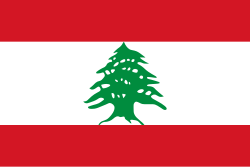
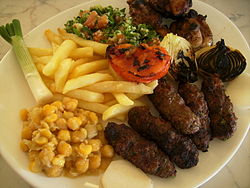
 KSF
KSF